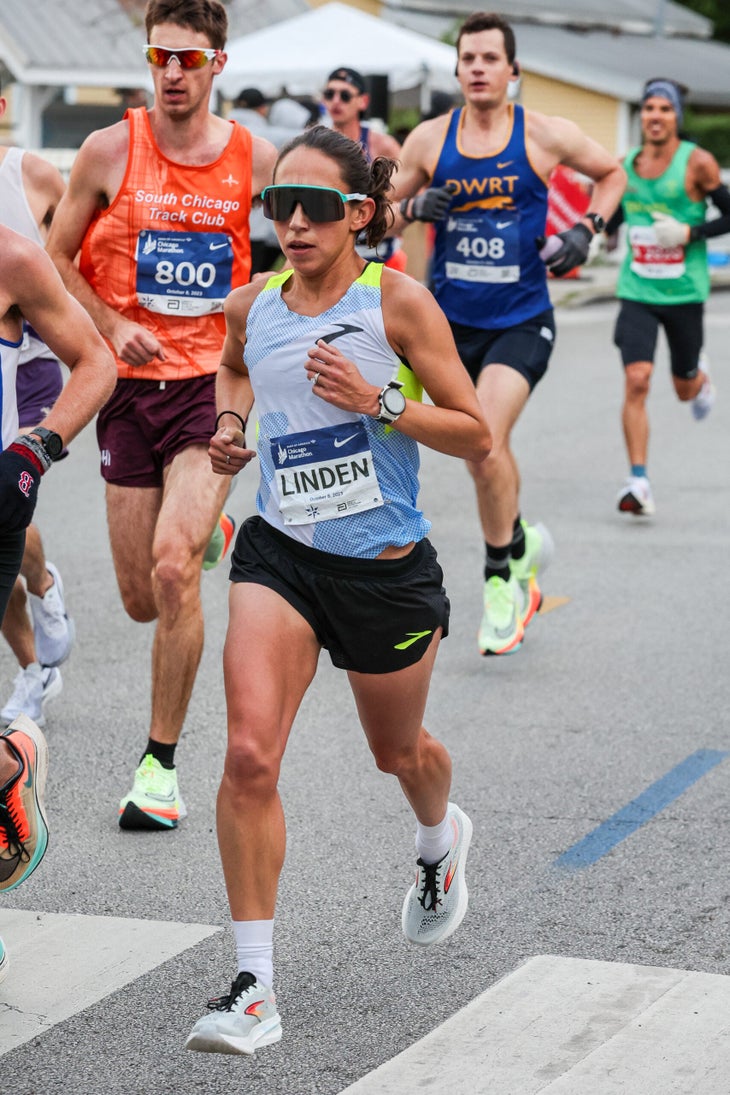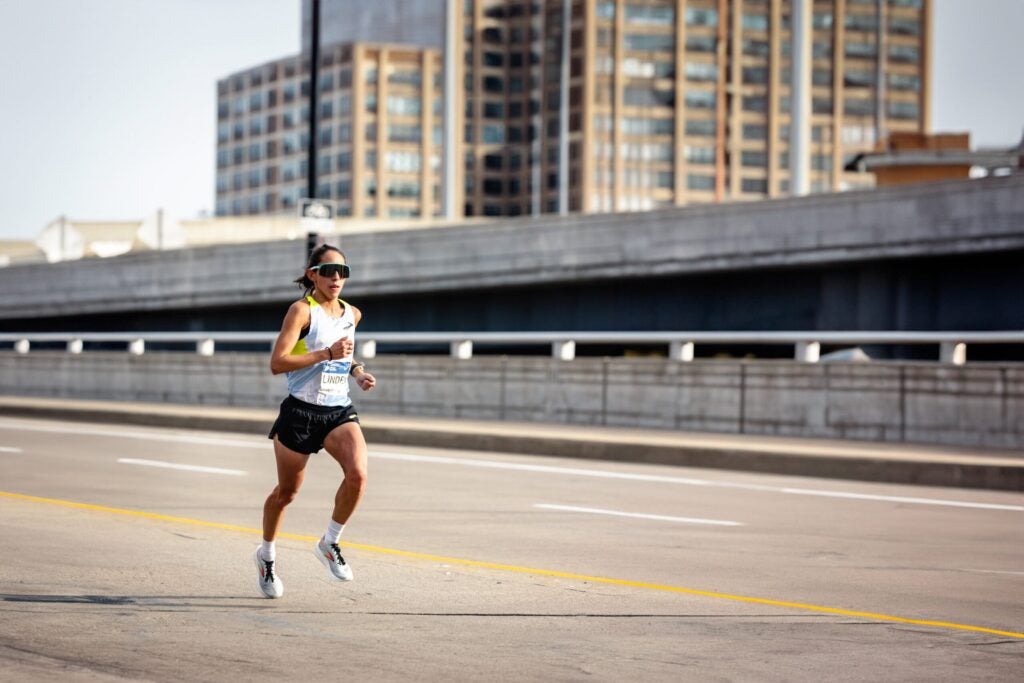No products in the cart.
Outdoor Adventure
Des Linden In Her Masters’ Era: ‘I’m Glad I’m 40’
Not everybody crosses over into the 40-plus age category in running with grace and fortitude, but Des Linden has managed to meet the milestone with ease—and, in fact, gratitude.
On Sunday at the 2023 Chicago Marathon, Linden, a two-time Olympian and the 2018 Boston Marathon champion, had one goal, and it wasn’t to win. She had her eye on setting a new American record masters record for the distance. And she did just that, finishing 16th in 2:27:35, just under Deena Kastor’s previous mark, 2:27:47, set in 2015.
Choosing to race on a flat, fast course like Chicago, with a specific time goal on deck, was a novel approach for Linden. For much of her career, she’s focused on races that demand strategy and competition over speed. But as she’s reached this point in her running career, she has to choose new objectives to keep it fun and interesting—and yes, realistic, too. With athletes like Sifan Hassan, who won on Sunday in 2:13:44, and Ruth Chepngetich, who took second in 2:15:37, Linden was well aware that her tactics would not include competing with the leaders, or even with the top Americans, who included Emily Sisson, the current American record holder (2:18:29), who placed seventh in 2:22:09.
Linden, who celebrated her birthday on July 26 with an ophthalmologist appointment (“This checks out,” she remembers thinking that day), said that chasing the masters record was the obvious goal when the calendar flipped. But had the mark not belonged to Kastor, the 2004 Olympic marathon bronze medalist, Linden doesn’t know if she would have been as excited to break it.
RELATED: Des Linden Reveals All Her Layers in New Memoir ‘Choosing to Run’
“[Kastor] is an icon, so it was fun to feel like I was chasing someone who I admire,” Linden said. “I also think it’s going to be hammered down in the next couple of years.”
Sara Hall, who is also 40, already clocked 2:25:48 at the 2023 Boston Marathon, but the course’s elevation drop and point-to-point route made the time record-ineligible. Then there’s Keira D’Amato, who ran her personal record 2:19:12 in 2022 and will turn 40 in October 2024. Several other highly competitive American women are approaching their late thirties now—in other words, like every other category in the sport, the masters are only getting faster.
After Tigst Assefa of Ethiopia smashed the women’s world record in September, finishing the Berlin Marathon in a mind-blowing 2:11:53, Linden knew she was born right on time—the shoe technology today has changed the entire game.
“I’m glad I’m 40 because the sport when I started? That’s a different sport,” Linden said. “If I had to peak in my career with the super shoes, maybe I’d break 2:20, which doesn’t put you in the conversation now. I don’t mean that as a knock on anyone, but if you want to be competitive, you’re going to have to level up and start believing that 2:14s are in your wheelhouse. So, I’m glad I’m 40.”
While the transition into the masters’ era is different for every runner—and especially for a professional like Linden—we can still glean a lot of solid advice from each other about how to maintain motivation and change our mindset as we grow up in running.
Here are three ways to make the most of the post-40 running life, just like Linden.
RELATED: Three Masters Athletes on Intersectional Wisdom for Lifelong Running

1. Don’t Count Yourself Out.
At the Chicago Marathon on Sunday, Lisa Levin, 49, finished in 3:11. Out of curiosity, she went back in the results archive to see what time she ran on the course 20 years ago. She was surprised to learn that at age 29, she finished in 3:11:01.
Levin, who is a running coach at Run Farther and Faster, alongside Julie Sapper, constantly tells her athletes that they shouldn’t assume that their athletic performances will automatically decline in their forties. While some people do see a change in their paces, many others can hang on to consistent performances well into their masters years.
“Many runners anticipate that there are going to be changes before they actually happen,” Levin said. “What it comes down to is not assuming that just because we’re getting older, we have to give up certain goals or that we can’t keep achieving PRs.”
Declines will come eventually, but don’t rush them—the timing is different for everybody and is determined by many factors (how many long breaks in training you’ve had or what age you started running, for example). For Linden, the next big race is the 2024 U.S. Olympic Marathon Trials, scheduled for February 3 in Orlando, Florida. She is approaching the preparation and the race with a different mindset than when she made the Olympic team in 2012 and 2016. The first time she lined up at the trials thinking, “I won’t be crushed if I don’t make it,” was in 2020, she said. But she finished fourth, one place shy of competing at her third Games. It stung a little bit more than she thought it would.
“It was still crushing, and I realized that it kind of meant more than I originally anticipated it would,” Linden said. “This time [in February], I want to go out and run to the best of my ability. It’s not totally impossible to have an outlier day, but I would still need a lot of people to have a rocky day for me to have a shot.”
Linden still finds the preparation for the trials exciting, but if she starts the training cycle and it isn’t going well, she isn’t opposed to pivoting to other goals, either.
“I don’t necessarily have to do this,” Linden said. “If I don’t think I am going to be able to have a good day, then I’ll figure out what’s exciting for me to do instead.”
RELATED: Armed with Smarts and Science, Camille Herron Sets an Astounding Record in Greece
2. Seek Joyful Running Endeavors.
Training seriously as we age gets tricky because we’re just, well, tired. Whether the training itself causes fatigue or the myriad responsibilities we have on our plates, like parenting, taking care of aging parents, careers, and more, we need more rest and recovery whenever we can get it. Given that fact, Levin and Sapper suggest that runners make certain that training is adding joy to life, not detracting from it. If time goals cause frustration or don’t seem to get you out the door to train anymore, switch it up.
“Maybe you’ve always been a marathoner, but you’ve never broken 20 minutes in the 5K. Or maybe you don’t want to run a certain time in the marathon but you’ve never negative-split one before,” Sapper said. “Like Des says, ‘Keep showing up.’ Your goals may look a little different, but that doesn’t mean they can’t continue to motivate you to be the competitive runner you are.”
Linden still leads the pro-runner’s life, but she also prioritizes sleep and doesn’t rush out the door just to have a workout done by 8 A.M. She’s made her routine more flexible, depending on how she’s feeling from day to day.
“I want to make sure I’m having a good experience,” Linden said. “One thing I really try to avoid is rushing out for a run just to feel like I’m getting it in. I’ll wait to feel like I’m excited and ready to run. I don’t want to feel like I’m just getting through it or getting it over with. I really want to enjoy it and appreciate it.”
RELATED: Sara Hall Shares 7 Keys to Her Longevity of Excellence
3. Recognize the Increase in Camaraderie and Competition.
Anecdotally, it seems like more people are running well into their forties, fifties, sixties, and beyond. Go to any local race and masters-aged runners are lining up in droves. It’s a great time to count yourself as one of the crew—and with so many peers, we can stop running with and comparing ourselves to the younger crowd.
Levin and Sapper coach several women in the 50- and 60-year-old age group who have found they don’t have much fun anymore running with groups that include people in their thirties and forties.
“Maybe you’re not compatible as training partners anymore—it’s better to find a group of people who are like-minded or can understand what your training is like at this stage,” Levin said.
Sapper finds a lot of camaraderie in the masters age groups and believes that more people are able to run longer now than ever before as the research starts to give more insight into how to support athletes as they age.
“Over the last decade, masters running has had such a surge—it’s more competitive,” Sapper said. “It’s a lot of fun to race people in your age group and also be inspired by the people 10 or 20 years above yours.”
RELATED: Des Linden Talks About Her Biggest Choices
4. Laugh it Off.
The Chicago Marathon on Sunday also served as the World Age Group championships, so those who were competing had their age groups pinned to their backs. Levin, with “45-49” displayed for all to see, was pleased with her performance but couldn’t help but notice toward the end of the 26.2 miles how many women in their 50s and 60s were passing her.
“I was like, ‘Where did you come from and how are you running like that?’” Levin said, laughing. “It has changed so much over the years, just how many masters women are out here running strong. It’s incredible and so inspiring.”
As for Linden, she also sees the humor in the clichéd aches and pains that happen at inopportune moments. Like, during the second half of the marathon on Sunday, when her pace slowed, and she felt a little chilled.
“In the most ‘old person’ comment ever, I was like, ‘My lower back is super tight,’” Linden said. “And then I was like, ‘If I’m going to keep doing this, I’m going to have to implement a weightlifting strategy. So, it’s on its way.”
As they say, Father Time is undefeated, even for the best of us.
“You have to adapt and adjust and figure out how to problem-solve for where you’re at, not for where you were, not for where you want to be, but just in the moment,” Linden said. “But it doesn’t have to be a sad story. It’s just part of the process and this part is fun, too.”
Source link

